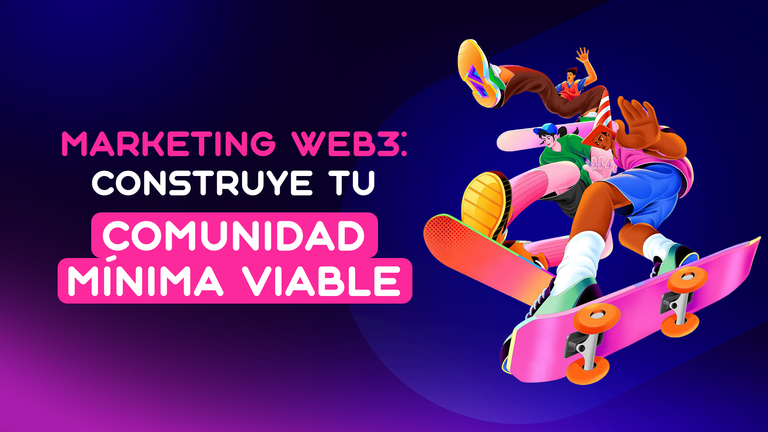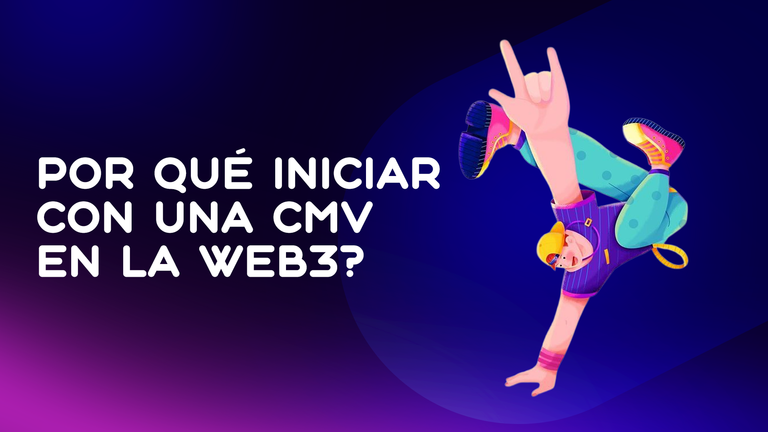
¡Saludos, Marketeros!
Una comunidad sólida, activa y comprometida es el pilar fundamental para cualquier proyecto Web3 exitoso. Pero, ¿cómo empezar una comunidad? Es la pregunta que se hacen la mayoria de los proyectos en etapa de incubación y la respuesta podría estar en una Comunidad Mínima Viable (CMV).
Pero,
¿Qué es una Comunidad Mínima Viable?
Imagina un pequeño grupo de personas con un propósito claro que los une. Eso es una CMV.
No se trata de una comunidad insípida y sin vida, sino de un grupo reducido de usuarios activos, interesados en un tema o tópico en específico; al interactuar con ellos, tendrás la información para recopilar feedback sobre si tu proyecto es viable y si será bien recibido por sus usuarios o no.

¿Por qué iniciar con una CMV en la Web3?
Construir comunidades no es tarea fácil, especialmente la Web3. Empezar con una CMV te permite:
- Optimizar: Evitas invertir tiempo y dinero en una comunidad que quizás no resuene con tu audiencia.
- Entender: Al interactuar con un grupo, obtienes información directa sobre lo que realmente valoran y buscan en una comunidad relacionada con tu proyecto.
- Iterar: El feedback temprano te permitirá ajustar tu estrategia y construir una comunidad que realmente satisfaga las necesidades de sus miembros.
- Validar: En un espacio donde las dinámicas comunitarias son aún emergentes, una CMV te permite experimentar y confirmar si existe un interés real en la comunidad que propones.

¿Cómo Iniciar una Comunidad Mínima Viable (CMV)?
En lugar de planificar de forma exhaustiva iniciar una comunidad compleja desde el inicio, la CMV se puede adaptar a las etapas tempranas de tu proyecto, pues se enfoca en crear un núcleo pequeño y dinámico para validar tu idea.
Estos son los pasos que debes seguir para construir tu CMV:
1. Define su propósito:
¿Por qué existirá esta comunidad? ¿Cuál es el problema que busca resolver o la necesidad que busca satisfacer?
Sé específico sobre el impacto: ¿Cómo sabrás que la comunidad está teniendo éxito?2. Identifica a las Personas Clave:
¿Para quién es esta comunidad? Define tu audiencia ideal. ¿Qué características, intereses o necesidades comparten?
Considera los primeros miembros; busca aquellos usuarios comprometidos con un tema o que ya estén intentando resolver el problema que tu comunidad aborda.3. Define la "Práctica" Inicial:
¿Qué actividades recurrentes ayudarán a alcanzar los objetivos? No necesitas tener todo planeado, pero define algunas interacciones básicas. Podría ser una reunión virtual semanal para compartir aprendizajes, o un espacio para colaborar con proyectos pequeños.4. Fomenta la Interacción Inicial:
Crea las primeras oportunidades para que los miembros interactúen. Plantea preguntas, comparte recursos iniciales, o propón un tema de discusión para la primera reunión.5. Define Métricas de Medición Iniciales:
¿Cómo vas a saber si tu CMV está generando valor? Define algunas métricas básicas para seguir el progreso inicial (ej: número de miembros activos, frecuencia de participación, tipo de interacciones).
En conclusión:
La Comunidad Mínima Viable se presenta como una estrategia inteligente y ágil para construir bases sólidas. Al enfocarte en un grupo reducido de miembros y en la validación temprana, puedes crear una comunidad que realmente conecte con tu audiencia y se convierta en un motor de crecimiento para tu proyecto.
Este blog te dió una base para entender las Comunidades Minimas Viables en Web3.
¿Hay algún tema relacionado a Marketing Web3 que te aprender en futuros posts?
Síguenos en X/Twitter para que sigas aprendiendo de Marketing Web3
X/Twitter: https://x.com/marketersweb3
Fuentes y Bibliografía:
1️⃣ Michelle Goodall.(2023). What is MVC - Minimal Viable Community?
2️⃣ Mich-Seth Owusu. (2023). Building Your Community as a Product: Starting with a Minimum Viable Community
3️⃣ Fatima Alvi. (2021). Minimum Viable Community: Designing the concept and prototype of your Community of Practice
4️⃣ Pam Magwaza. Minimum Viable Community(MVC)
Images created by our Design Team using Photoshop.
English Version

Greetings, Marketers!
A strong, active, and engaged community is the cornerstone of any successful Web3 project. But how do you start a community? This is the question most projects in the incubation stage ask themselves, and the answer may lie in a Minimum Viable Community (MVC).
But,
What is a Minimum Viable Community?
Imagine a small group of people with a clear purpose that unites them. That's an MVC.
It's not a bland, lifeless community, but rather a small group of active users interested in a specific subject or topic. By interacting with them, you'll have the information you need to gather feedback on whether your project is viable and whether it will be well received by its users.

Why start with a CMV in Web3?
Building communities is no easy task, especially in Web3. Starting with a CMV allows you to:
- Optimise: You avoid investing time and money in a community that may not resonate with your audience.
- Understand: By interacting with a group, you get direct feedback on what they really value and look for in a community related to your project.
- Iterate: Early feedback will allow you to adjust your strategy and build a community that truly meets the needs of its members.
- Validate: In a space where community dynamics are still emerging, a CMV allows you to experiment and confirm whether there is real interest in the community you are proposing.

How to Start a Minimum Viable Community (MVC)?
Instead of exhaustively planning to start a complex community from the outset, the MVC can be adapted to the early stages of your project, as it focuses on creating a small, dynamic core to validate your idea.
Here are the steps you need to follow to build your MVC:
1. Define its purpose:
Why will this community exist? What problem does it seek to solve or what need does it seek to meet?
Be specific about the impact: How will you know that the community is succeeding?2. Identify the Key People:
Who is this community for? Define your ideal audience. What characteristics, interests or needs do they share?
Consider the first members; look for users who are committed to a topic or who are already trying to solve the problem your community addresses.3. Define the initial ‘practice’:
What recurring activities will help achieve the objectives? You don't need to have everything planned out, but define some basic interactions. It could be a weekly virtual meeting to share learnings, or a space to collaborate on small projects.4. Encourage Initial Interaction:
Create the first opportunities for members to interact. Ask questions, share initial resources, or propose a discussion topic for the first meeting.5. Define Initial Measurement Metrics:
How will you know if your MVC is generating value? Define some basic metrics to track initial progress (e.g., number of active members, frequency of participation, type of interactions).
In conclusion:
The Minimum Viable Community is a smart and agile strategy for building a solid foundation. By focusing on a small group of members and early validation, you can create a community that truly connects with your audience and becomes a growth engine for your project.
This blog gave you a foundation for understanding Minimum Viable Communities in Web3.
Is there a topic related to Web3 Marketing that you would like to learn about in future posts?
Follow us on our social media channels to continue learning about Web3 Marketing.
X/Twitter: https://x.com/marketersweb3
Sources and Bibliography:
1️⃣ Michelle Goodall. (2023). What is MVC - Minimal Viable Community?
2️⃣ Mich-Seth Owusu. (2023). Building Your Community as a Product: Starting with a Minimum Viable Community
3️⃣ Fatima Alvi. (2021). Minimum Viable Community: Designing the concept and prototype of your Community of Practice
4️⃣ Pam Magwaza. Minimum Viable Community(MVC)
Images created by our Design Team using Photoshop.
Translated with DeepL.com